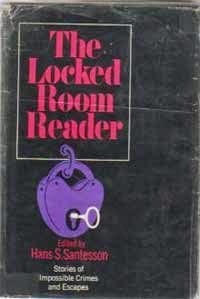"It is an old maxim of mine that when you have excluded the impossible, whatever remains, however improbable, must be the truth."- Sherlock Holmes ("The Adventure of the Beryl Coronet," from The Adventures of Sherlock Holmes, 1891)
This isn't going to be a third review in
as many days, I'm not that fast, but an update with some vague, weekend musings
thrown in.
First of all, I finally put the finishing
touch to the update of the largest post on this blog, "My
Favorite Locked Room Mysteries, Part I: The Novels," which is an 8-page
counting list of what I consider to be some of the finest impossible crime
novels in existence. This post will undoubtedly continue to expand further, but
this thorough rewrite of the list will buy me a year or two of neglect – before
another rigorous update is in order. Now it looks neat, tidy and ordered again.
I'll be redrafting, rewriting and
updating the sequel to that list, "My
Favorite Locked Room Mysteries, Part II: Short Stories and Novellas," when
I have reached the ending of The Black Lizard Big Book of Locked-Room
Mysteries (2014). The first two reviews from that monster anthology can be
found here
and here.
I'll probably squeeze in a review of Case
Closed, before returning to the Black Lizard book. There will
also be reviews of regular mystery novels interspersed with the ones tackling
Otto Penzler's anthology.
The blog for crime-fiction reviews and
news, Past
Offenses, fills us in on the third series of the BBC's Father Brown
and a rundown of the upcoming episodes reminded me why I passed on the previous
seasons. Well, the post warns to expect "the occasional squeal of anguish
from the G.K. Chesterton purists," but the original stories were set in the
early decades of the previous century and their author died in 1936 – yet the
series is (apparently) steeped in 1950s nostalgia!
I hear you say, "Oh, that’s just a
change in setting," but a glance at the episode description proves the snooty
purist correct. "The Invisible Man," from The Innocence of Father Brown
(1911), is one of those over anthologized, but landmark, stories in the
impossible crime genre and this is what they made of it,"the circus brings
death to Kembleford when a clown is murdered." What? This is going to be The
Mrs. Bradley Mysteries adaptation of The Rising of the Moon (1945)
all over again, isn't it? Oh, well, there's at least one detective fanboy who'll be glad to see
another clown dead, if only a fictional one.
On the death bed of 2014, I posted "The
Renaissance Era of Detective Fiction," which was a response to crime writer
and fellow mystery enthusiast, Martin Edwards, asking an important question on
his blog
– why are contemporary readers taking note of Golden Age detective stories
again? I compiled a rather long, rambling answer, but something occurred to me
later that should have been part of the post. Surely, I haven't been the only
one who left a bookstore, within a minute of entering, because of the usual
stock of contemporary crime novels – which gave since the early 2000s an expanding
group of customers to independent publishers, secondhand book dealers and a
growing interest for public domain work. We're now as far removed from the year
2000 as from 2030 and the clock is ticking on the expiration date of a lot of
copyrighted works from the Golden Age. So why not, from a publishers point of
view, make some bucks out of the best works and writers from the Golden Age, before
Gutenberg starts making them available in the decades ahead.
Finally, I deleted the badly written,
overlong introduction to the updated list of favorite locked room mysteries and
will probably rewrite it as a filler post entitled, "Why I Love Impossible
Crime Stories." Hey, I promised activity would (eventually) resume, which, by
the way, has been going on since September, 2014, showing an ascending line in
blog activity – one post at a time. Well, hopefully, I'll have a quick review
up tomorrow.
To be continued...


No comments:
Post a Comment